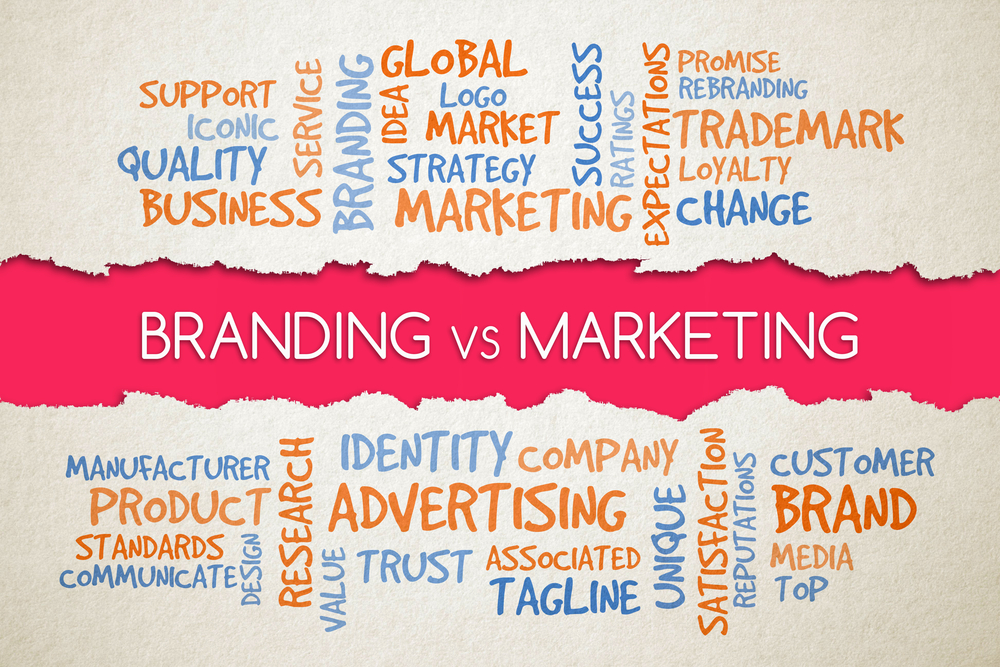As a business, whether you are starting or looking to rebrand or change the business, there are two things that you need to get right – the branding strategy and the marketing strategy.
However, many fail to separate those areas of strategy and get confused. These two are interrelated and closely connected. Arguably, one cannot exist without another but it is important to recognise the difference between the two.

Branding vs Marketing – The Basics
What is a Branding Strategy? – Branding is an aspect that makes up your business. It entails companies values, unique selling aspects, target audience and overall mission. The branding strategy deals with the audience’s experience with the company and must be considered carefully. Ensure that the branding strategy is well-defined – the audience must be clear about the company’s offer, not just with the product but also in terms of value, position and experience. Branding strategy also helps to strengthen internal relations – by aligning the departments, identifying opportunities and establishing guidelines for effective decision making.
What is a marketing strategy?
If branding strategy is what the audience is consuming, marketing is the vessel to serve. It deals with communication with your audience and the message to customers. Marketing covers the active promotion of the brand. It is specific with set goals and requires selecting target audiences.
Another key difference between branding strategy and marketing strategy is the difference between the duration of the goals and commitment. Branding strategy requires a long commitment, which needs to be channelled across all the campaigns. Marketing strategy is more flexible and can be influenced by time, considering the social events.
- While marketing is used to promote a specific product, branding is used to shape the brand identity of the business.
- Marketing gets the customers’ attention while branding helps to keep that attention
- Marketing gets in sales while branding drives recognition
- Branding the basis of marketing
- Branding is evergreen, marketing strategy keeps changing
- Marketing only has an impact on the customers, while branding as much impact on employees
No matter what industry you are in, you will find your company among a sea of other competitors. This creates a necessity to make waves and catch the attention of your audience.
But to have the audience’s attention, you need to have something that will help retain it for long – this is where branding plays its role. People want to buy products from brands they believe in and have their back – So even though marketing may seem to break the barrier and show your brand in front of an audience, you need to create a brand that people can relate with.
In short, you need the right set of marketing strategies that can set your brand apart from the competition and get your audience engaged. But for a brand to maintain a long-term relationship, you need branding.
Marketing generates sales, while branding creates loyalty.
At the core, most marketing strategies are driven to create results, and results that help generate sales, which is great and important to succeed as a company.
However, branding takes on a different approach. Branding is the solution to setting the foundation for long term growth and sustainability of the brand.
Just when you have the responses to those inquiries does it bode well to begin considering marketing. Since once you have your branding set up, you’ll have a superior comprehension of what your identity is, who your client is, and the most ideal approaches to associate with that client—and can construct a marketing procedure that rejuvenates that.
Branding comes first, then marketing
In the fabulous plan of building your business, branding consistently precedes marketing. What’s more, all things considered!, You can’t buy a large market brand you haven’t planned at this point.
Before you even consider setting up a marketing system, you need to zero in on your branding. Who are you as a brand? What would you like to bring to the commercial centre? What are your fundamental beliefs? Furthermore, in particular, how are you going to convey that to your objective clients?
Once you have your branding set up, you’ll have a superior comprehension of what your identity is, who your client is, and the most ideal approaches to associate with that client—and can assemble a marketing methodology that rejuvenates that.
Marketing is temporary while branding is forever
Branding is extraordinary. Regardless of where you are in your business, you’re continually going to be chipping away at characterizing who you are as an organization, creating your image’s insight with your audience, and encouraging a more profound, more significant relationship with your clients. As your organization develops and advances, you’ll need to develop and advance your branding directly alongside it.
Your branding can affect your team as it does your clients. Very much like you need your clients to have faith in your image to work with you, so do your representatives. At the point when you fabricate a brand that your team really has faith in, they will be more enthusiastic about and focused on their work. They’ll buckle down, propel themselves, and carry their best plans to the table—and your business will flourish, therefore.
Thus, it’s your team’s responsibility to foster your marketing procedure—yet in the event that you need to take your business to a higher level, it’s your duty to make a brand your team is amped up for.
SO WHAT NEXT?
Indeed, it’s simple.
To start with, get your branding procedure right. Consider what you’re offering to a client and how you satisfy that. Make an obvious action to back this contribution and back your central goal, your qualities and your character.
You can either do it with your marketing team or hire branding experts like Vowel to create a strong foundation for your marketing and branding strategy.
From that point, you have the whole plan of what you need to make a solid marketing strategy. Set aside some effort to comprehend your customers and what they need and serve them content they’ll be keen on.






